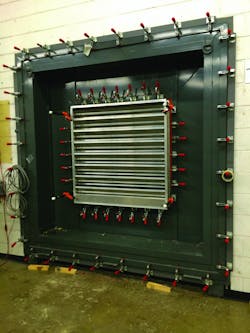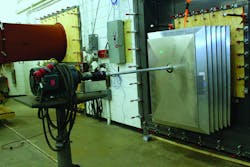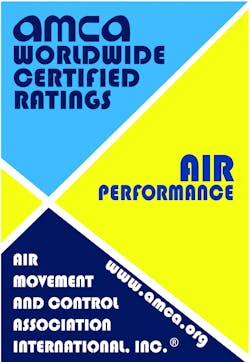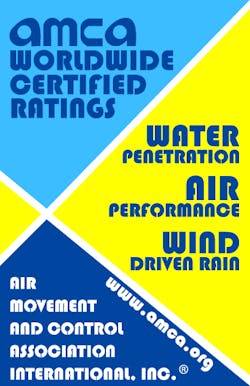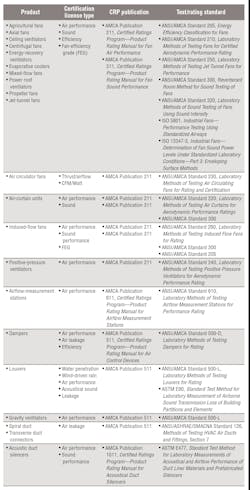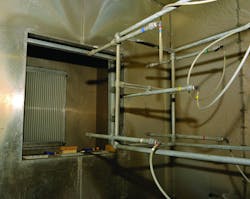AMCA International’s Certified Ratings Program
For nearly 50 years, Air Movement and Control Association (AMCA) International’s Certified Ratings Program (CRP) has been assuring buyers, specifiers, and users of air-movement and control devices that product lines have been tested and rated in conformance with AMCA standards and requirements. This article corrects a few common misconceptions about the AMCA CRP and provides some exemplary language to aid specification.
The AMCA CRP
AMCA certifies 21 air-movement and control products designed and fabricated for general-purpose installations in commercial, industrial, and residential facilities. Custom products cannot be certified.
The AMCA certification process is accredited by the American Association for Laboratory Accreditation to the requirements of ISO/IEC Guide 65, General Requirements for Bodies Operating Product Certification Systems. Soon, it will be accredited to the newer requirements of ISO/IEC 17065, Conformity Assessment—Requirements for Bodies Certifying Products, Processes and Services.
Currently, 231 manufacturers from around the world are enrolled in the AMCA CRP, accounting for a total of 3,245 products. Over the last five years, the number of manufacturers with certified products has increased by more than 33 percent, while the total number of certified products has increased by more than 28 percent.
AMCA Standards for Product-Rating Tests
AMCA publishes 13 American National Standards Institute- (ANSI-) accredited test standards for product rating: eight for fans, one for dampers, three for louvers, and one for air-measurement stations. The most widely applied is ANSI/AMCA Standard 210, Laboratory Methods of Testing Fans for Certified Aerodynamic Performance Rating, co-published by ASHRAE as ANSI/ASHRAE Standard 51, Laboratory Methods of Testing Fans for Certified Aerodynamic Performance Rating.
Test standards published by the International Organization for Standardization (ISO), ASTM International, ASHRAE, and the Sheet Metal and Air Conditioning Contractors’ National Association (SMACNA) are referenced in AMCA CRP documents.
In adherence to the ANSI consensus process, AMCA test standards are developed and revised by committees open to public participation. Committee participants do not have to work for companies that are members of AMCA. When test standards are open for development or revision, AMCA publishes notices on its website, and ANSI publishes announcements in its Standards Action newsletter.
AMCA Certification vs. Testing to AMCA Standards
A common area of confusion is the difference between a product that is AMCA-certified and one that was tested to an AMCA standard. A product that was tested to an AMCA standard is not necessarily an AMCA-certified product. To be AMCA-certified, a product is subject to a gauntlet of checks:
- Testing in AMCA’s laboratory, an AMCA independent accredited laboratory, or an AMCA-accredited laboratory.
- For testing in an AMCA-accredited laboratory, a precertification check test to ensure it will perform as shown by the applicant’s test results.
- Assurance it was tested in accordance with an approved standard.
- Assurance published ratings have been submitted to and approved by AMCA’s staff (published ratings are accessible at www.amca.org/certified).
- Check tests in either AMCA’s laboratory or an AMCA independent accredited laboratory every three years (after a product has passed three successive check tests, a longer interval between subsequent check tests is allowed).
Only a product that passes these checks is licensed to bear the AMCA seal (figures 1 and 2). AMCA CRP seals can be affixed to equipment and placed in catalogs and sizing/selection software.
All certified products are open to challenge testing initiated by a third party.
Uncertified products claimed to have been “tested in accordance with” an AMCA test standard undergo no scrutiny by AMCA.
AMCA publications with “11” in their reference numbers define and describe implementation of the CRP. AMCA Publication 11, Certified Ratings Program Operating Manual, sets the foundation for how the CRP works across all certifiable products and defines requirements for licensing the AMCA seal. AMCA Publication 211, Certified Ratings Program—Product Rating Manual for Fan Air Performance, sets forth requirements and processes for fan air performance and lists approved-rating test standards. AMCA Publication 311, Certified Ratings Program—Product Rating Manual for Fan Sound Performance, governs fan-sound ratings and certification. AMCA Publication 511, Certified Ratings Program—Product Rating Manual for Air Control Devices, covers damper and louver certification. All CRP publications are available at no cost at www.amca.org.
After including references to applicable AMCA CRP publications, specifiers have the option of writing in test standards approved for a given certification to provide additional confidence a product has undergone tests for important parameters. Approved test standards are listed in CRP publications.
AMCA offers many types of certifications. Fans, for example, can be certified for air performance, sound, and energy efficiency (Table 1).
About the AMCA Seal
Contrary to popular belief, the AMCA seal does not have to be affixed to products licensed to bear it. Thus, it is best to specify, “Products must be certified to bear the AMCA seal.” Language stating products must bear the AMCA seal can be satisfied by including manufacturer literature showing the AMCA seal for the type of certification for which the product is licensed.
As shown in Table 1, products can earn more than one type of certification. Usually, in such cases, certifications are combined into one seal, as shown in Figure 2.
Once licensed, AMCA CRP seals can be applied only in accordance with CRP publications. For example, seals must be directly and specifically associated with a product currently licensed to bear the AMCA seal and cannot be displayed on the cover of a catalog containing both licensed and unlicensed products.
Specifying Certified Products
When specifying AMCA-certified products, reference the appropriate AMCA CRP publication and, for added confidence, the appropriate test standard from Table 1. For example, for many types of fans, dampers, and louvers, product specifications can be written as follows:
- “Fan(s) shall comply with AMCA 11 and bear the AMCA-certified ratings seal for air performance and sound performance according to AMCA 211 and AMCA 311.”
- “Damper(s) shall be licensed to bear the AMCA-certified ratings seal for air performance, air leakage, and efficiency in accordance with AMCA 511.”
- “Louver(s) shall be licensed to bear the AMCA-certified ratings seal for air performance, wind-driven rain, and water penetration in accordance with AMCA 511.”
A specification including certification publications and test standards could read as follows: “The fan(s) must comply with AMCA 211 and be licensed to bear the AMCA Certified Rating Program seal. The fans shall be tested for air performance—flow rate, fan pressure, power, fan efficiency, air density, speed of rotation, and fan efficiency—according to AMCA 210/ASHRAE 51. Fan sound ratings shall be certified in compliance with AMCA 311 and shall comply with AMCA 301. The fans shall be tested according to AMCA 300.”
Summary
To ensure the success of specifications intending AMCA-certified products, reference the relevant AMCA CRP publications. Note the AMCA CRP seal does not have to be affixed to equipment; ask that submittals include evidence a product is licensed to bear the AMCA CRP seal, which could include manufacturer’s literature or other documentation showing the seal.
Note that a manufacturer’s claim a product has been tested in accordance with an AMCA test standard does not mean the product is AMCA-certified. Be aware that some manufacturers certify only parts of their product lines, and some products that were certified at one time may no longer be certified. For more information, go to www.amca.org/certified.
An expanded version of this article can be found on AMCA’s Website at www.amca.org/whitepapers.
Joe Brooks is director of certification, Lisa Ullrich is Certified Ratings Program manager, and Michael Ivanovich is director of industry relations for Air Movement and Control Association International.
Did you find this article useful? Send comments and suggestions to Executive Editor Scott Arnold at [email protected].


